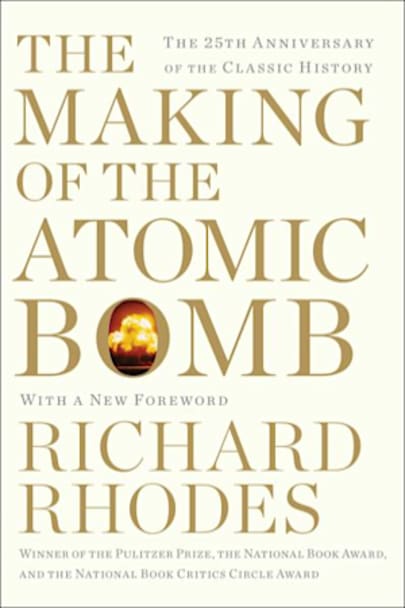Twenty-five years after its initial publication, The Making of the Atomic Bomb remains the definitive history of nuclear weapons and the Manhattan Project. From the turn-of-the-century discovery of nuclear energy to the dropping of the first bombs on Japan, Richard Rhodes’s Pulitzer Prize-winning book details the science, the people, and the socio-political realities that led to the development … development of the atomic bomb.
This sweeping account begins in the 19th century, with the discovery of nuclear fission, and continues to World War Two and the Americans’ race to beat Hitler’s Nazis. That competition launched the Manhattan Project and the nearly overnight construction of a vast military-industrial complex that culminated in the fateful dropping of the first bombs on Hiroshima and Nagasaki.
Reading like a character-driven suspense novel, the book introduces the players in this saga of physics, politics, and human psychology–from FDR and Einstein to the visionary scientists who pioneered quantum theory and the application of thermonuclear fission, including Planck, Szilard, Bohr, Oppenheimer, Fermi, Teller, Meitner, von Neumann, and Lawrence.
From nuclear power’s earliest foreshadowing in the work of H.G. Wells to the bright glare of Trinity at Alamogordo and the arms race of the Cold War, this dread invention forever changed the course of human history, and The Making of The Atomic Bomb provides a panoramic backdrop for that story.
Richard Rhodes’s ability to craft compelling biographical portraits is matched only by his rigorous scholarship. Told in rich human, political, and scientific detail that any reader can follow, The Making of the Atomic Bomb is a thought-provoking and masterful work.more



I enjoy reading books that put our times in perspective. They help me get beyond disturbing headlines and see how the changes we’re living through are part of the long, sordid story of human history.
The Making of the Atomic Bomb is a great example of such a book. It covers an enormous amount of ground, from early discoveries in nuclear physics at the University of Cambridge to Nagasaki and the end of World War II. The play-by-play history of scientific breakthroughs and the Manhattan Project that came out of them was fascinating. But I was most struck by the extent to which this bomb changed the world — and to which its development was essentially inevitable.
This was a trip! A journey back in time through the world of physics and all its wonderful genius characters. With backdrop of world wars, political and gender, and even religious struggle, one could easily imagine the Making of the Atomic Bomb as a series of period dramas, while keeping in mind the seriousness of the topic. This is a must read for anyone interested in science, history, non-fiction, politics, and the military.
This was a terrific book. It tells the story of the science and the people behind the development of the atomic bomb. The war and the effort in the US to develop a bomb is discussed in some detail. The efforts by other countries to develop a bomb is mentioned briefly. Mostly this is used as context to discuss the governments decisions to build and drop the bomb. And it has some powerful, terrible stories about the dropping of the bomb and its aftermath. Definitely recommended.
Terrific book on the building of the atomic bomb. Easy to read and understand as a layman. The author brought the reader along with the scientists who were developing the bomb, sharing their successes and their failures, as well as fears: will the atmosphere be ignited by the blast; would the earth be pushed out of its orbit. Great read! B. Hartney.
A fascinating history of how the giants of physics and chemistry came together to create the atomic era, unleashing both an era of boundless potential development as well as of unprecedented potential cataclysm. The ability of man to unleash the power of the atom is one of the truest swords of Damocles humanity has faced.
Simply wonderful. Jump in at any page and you’ll read it to the end.
I read Rhodes’s book when it first appeared and now have listened to the 25th-anniversary edition. What great storytelling within the history of 20th-century physics, the inhuman weaponry of WWII (Curtis LeMay is a primary villain), and, obviously, Los Alamos. Characters are drawn in their complexity, with Bohr as the great heroic figure. Readers may want to find a fuller biography of Robt. Oppenheimer, but there’s much here. This is a true classic.
I had never really understood the issues of physics and inorganic chemistry or the huge effort and politics behind the international movement towards atomic bombs. This is an educational and fascinating read.